Abstract
In this paper a dual band, a dual band Planar Inverted F antenna (PIFA) is designed for wireless communication intended to be used in wireless body sensor networks. The designed PIFA operates at two different frequency bands, 2.45 GHz Industrial, Scientific and Medical band (ISM) and 5.2 GHz (HiperLAN band). In body-centric wireless networks, antennas need to be integrated with wireless wearable sensors. An antenna is an essential part of wearable body sensor networks. For on-body communications, antennas need to be less sensitive to human body effects. For body-centric communications, wearable devices need to communicate with the devices located over the surface, and there is a need of communication from on-body devices to off-body units. Based on this need, a dual band planar inverted F antenna is designed that works at two different frequency bands, i.e., 2.45 GHz and 5.2 GHz. The 2.45 GHz is proposed for establishing communication among the wireless sensor devices attached to the human body, while 5.2 GHz is proposed for the communications for from on-body to off-body devices. The proposed antenna is very compact, and due to having ground plane at the backside it is less sensitive to the effects of the human body tissues. Computer Simulation Technology (CST) microwave studio™ was used for antenna design and simulation purposes. Performance parameters such as return loss, bandwidth, radiation pattern and efficiency of this antenna are shown and investigated. These performance parameters of the proposed antenna have been investigated at free space and close proximity to the human body. Simulation results and analysis show that the performance parameters produce very good results for both frequency bands. Due to its compact size, low sensitivity to human body tissues, and dual band functionality, it will be a good candidate for wireless wearable body sensor networks.
1. Introduction
In Wireless Body Sensors Networks (WBSANs), the wireless connectivity between body-centric units is provided through the placement of sensor and compact antennas. Recently, an amassed interest in body-centric wireless communications has made the research field very popular. Wireless sensor and body area networks are striking solutions that can be used in healthcare applications, which require constant monitoring of health data and constant access to the patient. In WBSANs communication, wireless connectivity between body-centric units is provided through the deployment of sensor and compact antennas [1,2,3]. Body-worn antennas can suffer from reduced efficiency and gain, due to electromagnetic immersion in tissue, radiation pattern fragmentation, variations in feed point impedance, and frequency detuning [1,2,3,4,5]. It was predicted that wireless sensor solutions could save $25 billion worldwide in annual healthcare costs by drastically reducinghospitalizations and extending independent living for the elderly [1].
In common healthcare monitoring scenarios, it is very essential for the antenna to communicate among the devices on the body and off-body devices. On-body-communication defines communication between body-mounted devices and off-body communication defines the communication from body worn devices and base units or mobile devices located in surrounding environments [6]. Lately, designing wearable antennas has gained increasing interest in research and development for body sensor networks [2,3,4,5,7]. The Planar Inverted-F Antenna (PIFA) has been prevailing for handling wireless devices because of its many characteristics such as simple design, lightweight, low cost, compactness, conformable nature, and reliable performance [2,6,7,8]. Previously, many researchers have designed wearable antennas for on-body communications at 2.45 GHz and ultra-wideband (UWB) at 3.1~10.6 GHz [3,4,6,9,10,11,12,13,14]. However, antennas of wireless body sensors networks need to communicate withbody-mounted devices and off-body devices.
In this paper, a dual band planar inverted F antenna (PIFA) is designed for both on- and off-body communications. Performance of proposed antenna is studied in free space and on the three-layered human body model. The antenna operates at two frequency bands, i.e., 2.45 GHz (ISM band) and 5.2 GHz (Hiperlan band). The 2.45 GHz is designed for communication between the devices attached on the human body, and 5.2 GHz is used for the communication from body-mounted devices to off-body devices.
2. Proposed PIFA Antenna Design
The proposed PIFA is comprised of a rectangular planar element located above a ground plane, a shorting pin, and feeding pin for the planar element. Computer Simulation Technology (CST) microwave studio™ software was used for the design and results of the antenna. The software design and schematic drawing of the dual band PIFA is presented in Figure 1. The antenna was designed on FR4 substrate with a thickness of 1.52 mm and a relative permittivity of 4.6. In this proposed design, there is full ground plane of the antenna. The size of the ground plane is 63 mm × 34 mm, and the total height of the antenna is 6.92 mm.
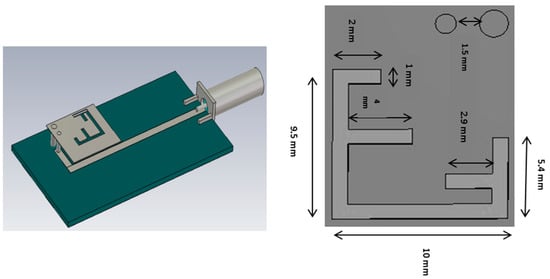
Figure 1.
Developed antenna software design of the Planar Inverted F antenna (PIFA), and schematic diagram of the PIFA.
Microstrip feed line was used to excite this antenna. The gap between the shorting pin and the feeding pin is 1.5 mm. The aim of the shorting pin of the PIFA is to reduce the size of the antenna and to achieve impedance matching [9,15,16]. The radiating element of rectangular PIFA works at the lower frequency band (2.45 GHz). The double F shape slits are introduced on the antenna structure with a view to achieving 5.2 GHz band. The bandwidth of the dual band PIFA can be achieved by changing radiating element size, changing the width of the shorting pin, and adding slot on the ground plane.
3. Results and Analysis
The antenna first was designed using CST software as mentioned earlier. The free space design performance parameters of the antenna were extracted, and then the antenna was placed on the three-layered human body model in order to study the effects of human body on the antenna performance parameters. Figure 2 shows the antenna on the designed three-layered human body model. In this study, three-layered (skin, fat, and muscle) of rectangular human model is created with human tissue electrical properties defined at 2.45 GHz and 5.2 GHz, respectively. For 2.45 GHz, relative permittivity and conductivity used for skin, fat, and muscle are 38.007 and 1.464 (S/m), 5.2801 and 0.10452 (S/m), and 52.729 and 1.7388 (S/m), respectively. Similarly for 5.2 GHz, relative permittivity and conductivity for skin, fat, and muscle are 35.618 and 3.2106 (S/m), 5.0113 and 0.25407 (S/m),and 49.292 and 4.2556 (S/m), respectively [17]. The distance between the antenna and the three-layered human body model was 8 mm.
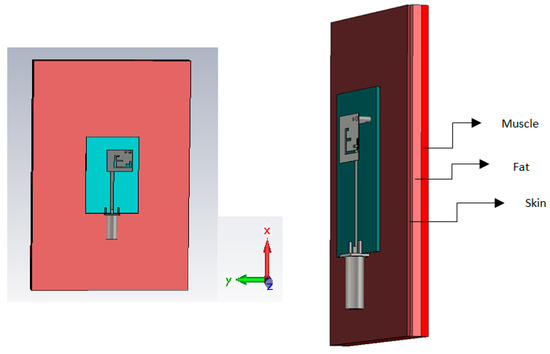
Figure 2.
Antenna on three-layered human body model.
The free space and on-body return loss response of the antenna is presented in Figure 3. In Figure 3, it is noticed that the antenna works at two different frequencies, which are 2.438 GHz (ISM Band) and 5.2 GHz (HiperLAN band). The antenna shows good return loss responses at both frequency bands of operations. Very slight frequency detuning is noticed, which is due to the dielectric properties of human body lossy tissues. It is interesting that the return loss improves at both frequencies when placed on the human three-layered model. Return loss and frequency are much less sensitive on the human body, which proves suitability of the antenna for WBSNS.
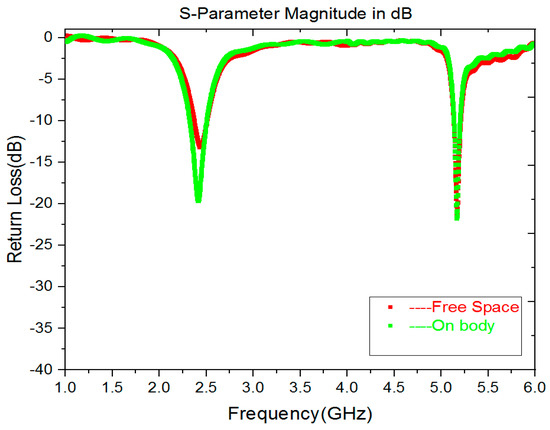
Figure 3.
Free space and on-body return loss responses of the PIFA.
If frequency is out of range, there will be serious problem and the return loss will show power loss transmission capability. Since the rerun losses in both cases are more than −10 dB, more than 90% power will be transferred, providing that the antenna is good for power-efficient communication in WBSNs. The antenna shows 136.3 MHz bandwidth at −10 dB impedance at lower frequency, and at higher frequency the bandwidth is noticed to be 73 MHz. When the antenna is placed on the three layer human body model, the bandwidth increases for the lower frequency band while decrease of bandwidth is noticed for the higher frequency band. The antenna shows required ISM band bandwidth (88 MHz) even placing on the body. List of detailed results about antenna parameters is listed in Table 1.

Table 1.
Comparison of performance parameters of the PIFA (free space and on-body).
The PIFA shows a maximum peak gain of 3.77 dBi at 2.45 GHz, while 2.53 dBi gain is noticed at 5.2 GHz. After the simulation on the three-layered human body model, a decrease of 0.9 dB gain is noticed at lower band but increase of 1.21 dB is noticed for higher frequency band. Even on the body, the antenna shows excellent gains that are enough for both frequency bands to transmit power efficiently with efficient link power. The free space radiation efficiency of the proposed PIFA is 98.64% and 94.43% at lower and higher bands, respectively.
When it is placed on the body due to lossy human body tissues, reductions of 36. 98% at 2.45 GHz and 25% at 5.2 GHz are noticed. Although the reduction of radiation efficiency is noticed, the radiation efficiency is still very good for both bands. The lower reduction of radiation efficiency is due the ground plane of the antenna at the backside that acts as a shield between the body and the antenna.
Free space and on-body radiation patterns at both frequency bands of the antenna are presented in Figure 4 and Figure 5. From the graph, it is noticed that when antenna is simulated on the human body the radiation patterns of the antenna at both bands do not deform but power levels vary slightly. The results of the radiation patterns at both frequencies of the PIFA show that the antenna will show good performance for establishing power efficient communication between the devices located on the body and also on off-body devices.
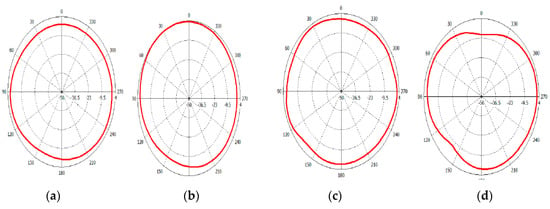
Figure 4.
Free space radiation pattern at (a) XY Plane at 2.438 GHz, (b) YZ Plane at 2.438 GHz, (c) XY Plane at 5.168 GHz, and (d) YZ Plane at 5.168 GHz.
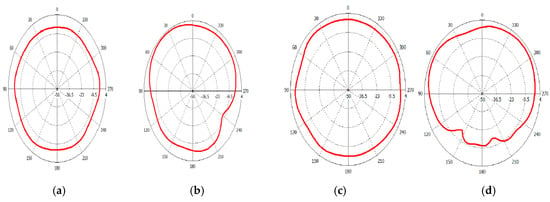
Figure 5.
On-body radiation pattern at (a) XY Plane at 2.438 GHz, (b) YZ Plane at 2.438 GHz, (c) XY Plane at 5.168 GHz, and (d) YZ Plane at 5.168 GHz.
4. Conclusions
A simulated compact dual band PIFA antenna design is presented. Free space and on-body performance parameters of this antenna for communication between on-body devices and off-body devices are investigated and analyzed. The antenna is proposed for power-efficient communications for wireless body area sensor networks. Having a full ground plane at the backside of the antenna produces much less sensitivity from human body lossy tissues when placed on the human body three-layered model. Results and analysis show the very good free space and on-body performance parameters of the antenna. Due to its compact size, dual band functionality, and very good on-body results, it will be a suitable candidate for both on-body and off-body communications in wireless body sensors networks.
Funding
The project was self-funded. It is a simulation-based work, and the author designed and simulated the antenna himself.
Acknowledgments
The author would like to thank North South University for providing him with an office space and a desktop for doing the simulation and research work after his teaching hours.
Conflicts of Interest
The author of this paper declares no conflict of interest.
References
- WSN for Healthcare: A Market Dynamics Report. Available online: http://www.onworld.com/healthcare.index.html (accessed on 7 August 2008).
- Liu, Z.D.; Hall, P.S.; Wake, D. Dual-Frequency Planar Inverted-F Antenna. IEEE Trans. Antennas Propag. 1997, 45, 1451–1458. [Google Scholar]
- Otto, C.; Milenkovic, A.; Sanders, C.; Jovanov, E. System Architecture for a Wireless Body Area Network for Ubiquitous Healthcare Monitoring. J. Mob. Multimed. 2006, 1, 307–326. [Google Scholar]
- Cotton, S.L.; Scanlon, W.G. An experimental investigation into the influence of user state and environment on fading characteristics in wireless body area networks at 2.45 GHz. IEEE Trans. Wirel. Commun. 2009, 8, 6–12. [Google Scholar] [CrossRef]
- Patel, M.; Wang, J. Applications, Challenges, and Prospective in Emerging Body Area Networking Technologies. IEEE Wirel. Commun. 2010, 17, 80–88. [Google Scholar] [CrossRef]
- Hall, P.S.; Hao, Y. Antennas and Propagation for Body-Centric Wireless Communications, 2nd ed.; Artech House: Norwood, MA, USA, 2006. [Google Scholar]
- Hall, P.S.; Hao, Y. Antennas and Propagation for Body Centric Wireless Communications; Artech House: Boston, MA, USA; London, UK, 2006. [Google Scholar]
- Misran, N.; Yunus, M.M.; Islam, M.T. Small Dual-Band Planar Antenna with Folded Patch Feed. J. Appl. Sci. Res. 2010, 6, 1975–1980. [Google Scholar]
- Stutzman, W.L.; Thiele, G.A. Antenna Theory and Design; John Wiley & Sons, Inc.: Hoboken, NJ, USA, 1998. [Google Scholar]
- Alomainy, A.; Hao, Y.; Davenport, D.M. Parametric Study of Wearable Antennas Varying Distances from the Body and Different On-Body Positions; IET: London, UK, 2007; pp. 84–89. [Google Scholar]
- Scanlon, W.G.; Evans, N.E. Numerical analysis of body worn UHF antenna systems. Electron. Common. Eng. J. 2001, 13, 53–64. [Google Scholar] [CrossRef]
- Sun, Y.Y.; Cheung, S.W.; Yuk, T.I. Planar monopoles with different radiator shapes for UWB Body-Centric Wireless Communications. J. Eng. 2013. [Google Scholar] [CrossRef]
- Abbasi, Q.H.; Khan, M.M.; Liquate, S.; Kamran, M.; Alomainy, A.; Hao, Y. Experimental investigation of ultra-wide band diversity techniques for on-body radio communications. Prog. Electromagn. Res. C 2013, 34, 165–181. [Google Scholar] [CrossRef]
- Khan, M.M.; Abbasi, Q.H.; Alomainy, A.; Hao, Y. Performance of ultra-wideband wireless tags for on-body radio channel Characterisation. Int. J. Antennas Propag. 2012, 2012, 232564. [Google Scholar] [CrossRef]
- Guha, D.; Antar, Y.M.M. Microstrip and Printed Antennas: New Trends, Techniques and Applications; Wiley-Blackwell: Hoboken, NJ, USA, 2011; ISBN 0470681926. [Google Scholar]
- Rappaport, T.S. Wireless Communications: Principles and Practice; Prentice Hall Communications Engineering and Emerging Technologies Series; Prentice Hall PTR: NJ, USA, 1999. [Google Scholar]
- Calculation of the Dielectric Properties of Body Tissues. Institute for Applied Physics, Italian National Research Council. Available online: http://niremf.ifac.cnr.it/tissprop/ (accessed on 5 November 2010).
Publisher’s Note: MDPI stays neutral with regard to jurisdictional claims in published maps and institutional affiliations. |
© 2020 by the authors. Licensee MDPI, Basel, Switzerland. This article is an open access article distributed under the terms and conditions of the Creative Commons Attribution (CC BY) license (https://creativecommons.org/licenses/by/4.0/).